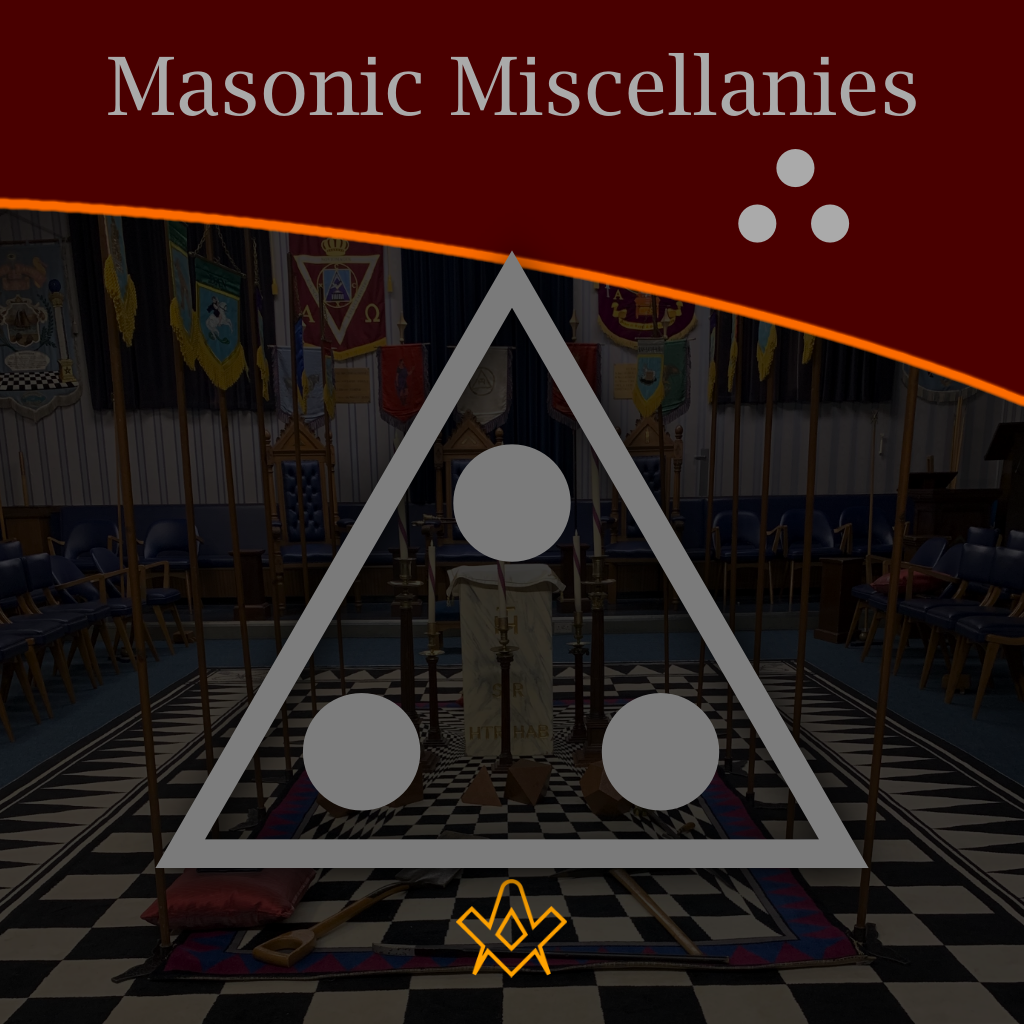Three dots (or points) in an upright triangular shape ∴ is most commonly known as the ‘therefore’ sign – so why is it used in Freemasonry?

“In logical argument and mathematical proof, the therefore sign, ∴, is generally used before a logical consequence, such as the conclusion of a syllogism.
The symbol consists of three dots placed in an upright triangle and is read therefore. While it is not generally used in formal writing, it is used in mathematics and shorthand.
The symbol is also used in meteorology, the ‘therefore’ sign is used to indicate ‘moderate rain’ on a station model; the similar typographic symbol asterism (⁂, three asterisks) indicates moderate snow.”
Source: – Wikipedia

A Masonic document in French using a number of abbreviations. – By Christophe Dioux – Own work
IMAGE LINKED: wikimedia Attribution 4.0 International (CC BY 4.0)
However, in Freemasonry, the symbol is used to indicate a Masonic abbreviation.
Albert G. Mackey, in his Encyclopedia of Freemasonry, explains the meaning and usage of the “three points” [dots]:
Abbreviations of technical terms or of official titles are of very extensive use in Masonry.
They were, however, but rarely employed in the earlier Masonic publications.
For instance, not one is to be found in the first edition of Anderson’s Constitutions.
Within a comparatively recent period they have greatly increased, especially among French writers, and a familiarity with them is therefore essentially necessary to the Masonic student. Frequently, among English and always among French authors, a Masonic abbreviation is distinguished by three points ∴ in a triangular form following the letter, which peculiar mark was first used, according to Ragon, on the 12th of August, 1774, by the Grand Orient of France, in an address to its subordinates.
No authoritative explanation of the meaning of these points has been given, but they may be supposed to refer to the three lights around the altar, or perhaps more generally to the number three, and to the triangle, both important symbols in the Masonic system.
Before proceeding to give a list of the principal abbreviations, it may be observed that the doubling of a letter is intended to express the plural of that word of which the single letter is the abbreviation.
Thus, in French F∴ signifies “Frere”, or “Brother”, and FF∴ “Freres”, or “Brothers”.
And in English L∴ and LL∴ to denote “Lodges”. This remark is made once for all, because I have not deemed it necessary to augment the size of the list of abbreviations by inserting these plurals.
If the reader finds S∴ G∴ I∴ Sovereign Grand Inspector, he will be at no loss to know that SS∴ GG∴ II∴ must denote “Sovereign Grand Inspectors”… [p.2]
Three points in a triangular form (∴) are placed after letters in a Masonic document to indicate that such letters are the initials of a Masonic title or of a technical word in Masonry, as G∴ M∴ for Grand Master, or G∴ L∴ for Grand Lodge.
It is not a symbol, but simply a mark of abbreviation.
The attempt, therefore, to trace it to the Hebrew three yods, a Kabbalistic sign of the Tetragrammaton, or any other ancient symbol, is futile.
It is an abbreviation, and nothing more; although it is probable that the idea was suggested by the sacred character of the number three as a Masonic number, and these three dots might refer to the position of the three officers in a French Lodge.
Ragon says (Orthod . Macon., p. 71,) that the mark was first used by the Grand Orient of France in a circular issued August 12, 1774, in which we read “G∴ O∴ de France.”
The abbreviation is now constantly used in French documents, and, although not accepted by the English Masons, has been very generally adopted in other countries.
In the United States, the use of this abbreviation is gradually extending… [p.815]
In the French and Scottish Rites, the Wardens are in the West, the Senior in the North-west and the Junior in the South-west; but in all, the triangular position of the three officers relatively to each other is preserved; for a triangle being formed within the square of the Lodge, the Master and Wardens will each occupy one of the three points. [p.866]
There is also an expression Frére/s Trois-Points (Three-Point Brother/s) which is a pejorative anti-Masonic term meaning ‘Freemason”, which again refers to the “three points arranged in a triangle constituting a symbol related to Freemasonry.
The use of these three points spread from the 18th century for the signature of confidential documents”.
The infamous anti-Masonic author Léo Taxil used the term in the title of his book ‘Complete Revelations On Freemasonry – Le Fréres Trois-Points’ (1885).
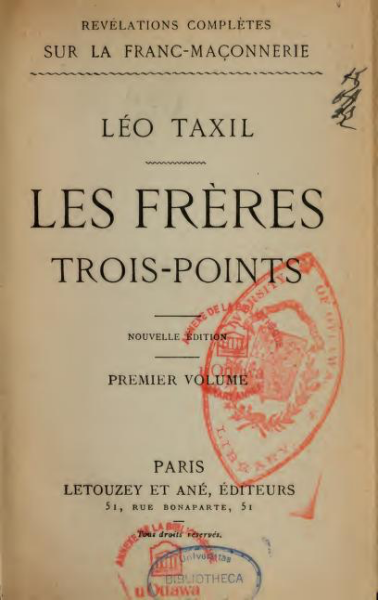
Title page of Taxil’s anti-Masonic book (1885)
Further Reading:
The full list of Masonic abbreviations from Mackey’s Encyclopaedia of Freemasonry
Source: Wikipedia
[Publisher’s Note: The 3 dots are often currently found in social media channels. Users in Linked-in often use the 3 dots .: or .’. to signify they are Freemasons. Also the emoji ![]() is used to signify the “sprig of acacia” a sign of a Freemason. The characters /G\ are also used to signify a Freemason]
is used to signify the “sprig of acacia” a sign of a Freemason. The characters /G\ are also used to signify a Freemason]

Mackey’s Encyclopaedia of Freemasonry
By: A Mackey
Dr. Albert G. Mackey, also the author of The Lexicon of Freemasonry appears as author of this ” Encyclopedia of Freemasonry and its Kindred Sciences,” which, being a library in inself, superseded most of the Masonic works which have been tolerated by the craft—chiefly because none better could be obtained.
Here, in one giant volume is a work which fulfils the hope which sustained the author through ten years’ literary labor, that, under one cover he “would furnish every Mason who might consult its pages the means of acquiring a knowledge of all matters connected with the science, the philosophy, and the history of his order.”
For more than thirty years Dr. Mackey has devoted earnest and constant study and research to the history, the objects, and the condition of Masonry.
In the present work, the crowning and successful result of a life’s labors, he has received no assistance from any one.
He says, ” Every article was written by myself,” and he adds, which would extenuate errors, had he fallen into any, “For twelve months, too, of the time occupied upon this work, I suffered from an affection of the sight, which forbade all use of the eyes for purposes of study.
During that time, now happily passed, all authorities were consulted by the willing eyes of my daughters—all writing was done by their hands.
I realized for a time the picture so often painted of the blind bard dictating his sublime verses to his daughters,” and his preface closes with the words, “Were I to dedicate this work at all, my dedication should be—To Filial Affection.”
Up to the present time the modern literature of Freemasonry has been diffuse, lumbering, unreliable, and, out of all reasonable proportions.
Recent Articles: Masonic Miscellanies
 Masonic Miscellanies - The Amulet of the Ladder Explore the cosmic significance of the Ladder in ancient Egyptian mythology through Wallis Budge's "Egyptian Magic." Discover how this profound symbol bridges the mortal and divine, encapsulating the Egyptians' fervent afterlife aspirations with a blend of myth, magic, and material culture. Dive into the celestial ascent of Osiris and mortal souls. |
 Masonic Miscellanies - Adulterine Gilds Guilds, the associations that shaped medieval European society, were more than just organizations of artisans and merchants. They played a vital role in the economic and social development of towns and cities. This exploration delves into the intriguing concept of adulterine gilds and their interconnectedness with guilds, offering insight into the significance of legal authorization and recognition in medieval Europe. |
 Masonic Miscellanies - Masonic Orb Discover the fascinating world of Masonic ball watch fobs, intricately crafted with tiny pyramids that form a cross when opened. These decorative accessories were all the rage in the late 1800s and early 1900s, and they still hold a certain allure today. Explore the different varieties and symbols found on these unique pieces that carry deep Masonic meaning. |
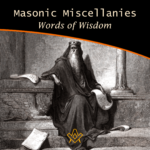 Masonic Miscellanies – Words of Wisdom Uncover timeless wisdom from King Solomon to Albert Pike in our latest Masonic Miscellanies, a treasure trove of insights for Masons. Journey through the ages and glean inspiring sayings, reflecting on their profound influence on Masonic principles. An enriching read for the enlightened. |
 Masonic Miscellanies - Symbolism of the Right Hand Unlock the enigmatic realm of Freemasonry as we delve into its age-old symbols, rituals, and philosophies. This thought-provoking exploration, drawn from Mackey's Revised Encyclopedia of Freemasonry, focuses on the iconic 'right hand' symbol - its rich history, universality, and profound significance. |
 Masonic Miscellanies - Order of the Secret Monitor Unveil the mystery of Freemasonry with 'The Order of the Secret Monitor'. Discover this lesser-known appendant order, its unique rituals, and the profound teachings it offers. Explore the bonds of friendship and brotherhood it fosters, all wrapped in an intriguing cloak of mystery. Your journey into the depths of Masonic wisdom begins here. |
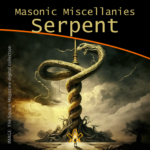 Masonic Miscellanies - The Symbol of the Serpent As a symbol, the serpent obtained a prominent place in all the ancient initiations and religions. |
 Masonic Miscellanies - The Four Veils in Royal Arch Masonry What are the four veils in Royal Arch Masonry? And what is the 'Ceremony of Passing the Veils'? Although common throughout Scotland, Ireland and the United States, it is mostly unknown in England, presently only worked in the Province of Bristol. ( and by dispensation ) |
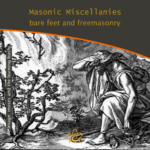 Masonic Miscellanies - Bare feet and Freemasonry A candidate for initiation into a Masonic Lodge often finds the requirements which he/she must fulfil somewhat odd. The mode of preparation often remains a puzzle, since the ritualistic explanation is not offered in full. Why are we 'slipshod' or "bare-footed" in Masonic Ritual? |
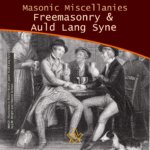 Masonic Miscellanies – Freemasonry and Auld Lang Syne Millions of people throughout the world will sing Auld Lang Syne to see out the Old Year. Few will know all the words, fewer still know what they mean, or that there is a link to Freemasonry. |
 Masonic Miscellanies - The Mosaic Pavement - why mosaic, why pavement? We are all familiar with the black and white chequered flooring of the Masonic lodge but where did it originate? There are a few theories… |
 Masonic Miscellanies – Masonic Master's Carpets Have you got a magic "Masonic Master's Carpet" in your lodge? I say 'magic' with my tongue firmly in my cheek because (as far as I know) these fabulous works of art don't bestow any mystical powers but can bestow some educational ones! However, considering their possible value today, they may magic up some interest (or funds). |
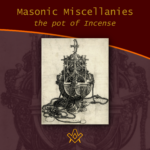 Masonic Miscellanies – The Pot of Incense Just when the pot of incense became an emblem of the third section of the Sublime Degree can not be stated with certainty. It is, apparently, an American invention or addition. But what does it symbolise? |
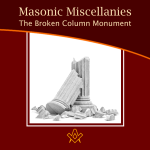 Masonic Miscellanies - The Broken Column Monument The story of the broken column was first illustrated by Amos Doolittle in the "True Masonic Chart" by Jeremy Cross, published in 1819. |
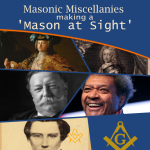 Masonic Miscellanies - Making a 'Mason at Sight' What does it mean to make a 'Mason at sight', and who was made one? |
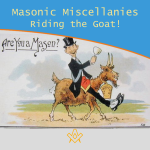 Masonic Miscellanies - Riding the Goat! Many Freemasons will have come across the phrase 'riding the goat', and will no doubt have been the butt of a joke about it (sorry, I couldn't resist!) But what does it mean and where did the phrase come from? |
 Masonic Miscellanies - What are the 'three dots'? Three dots or points in an upright triangular shape ∴ is most commonly known as the 'therefore' sign – so why is it used in Freemasonry? |
 Masonic Miscellanies - Keep Within Compass This month we discover a series of allegorical prints warning us to "Keep within Compass and you shall be sure, to avoid many troubles which others endure." |
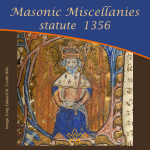 Masonic Miscellanies - statute 1356 Further to the reference in the article – The Builders - 6 - Free-Masons 'a statute was enacted against the Free-masons in 1356' – Regulations for masons who are hewers, on the one hand, and the light masons and setters on the other. |
 Masonic Miscellanies - An Anti-Masonic 'Apron'? The Anti-Masonic 'Apron' was created during the 1832 Presidential election in USA. It was not Ani-masonic. And it was not an apron. Read on to find out what and why it was created. |
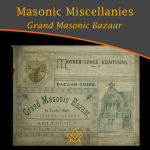 Masonic Miscellanies - Grand Masonic Bazaar (1895) Grand Masonic Bazaar (1895); to raise funds to clear the debt incurred by “Mother Kilwinning” in rebuilding their Lodge. |
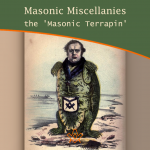 Masonic Miscellanies - the 'Masonic Terrapin' A satirical book from 1851 includes a bizarre caricature of a 'Masonic Terrapin' - all I can say is 'read on'… |
 Masonic Miscellanies - Masonic Bookplates You probably know what a bookplate is for, but did you know that the earliest known book mark/label dates from the reign of Amenhotep III in Egypt around 1391−1353 BCE?! |
 Masonic Miscellanies - Freemasonry & Bees Freemasonry & Bees - what's the buzz? The bee was among the Egyptians the symbol of an obedient people, because, says Horapollo, of all insects, the bee alone had a king. |
 Masonic Miscellanies - The mystery of the Tattooed Freemason In 1894, the body of a drowned man was found in the Bay of San Francisco - what they discovered was amazing. |
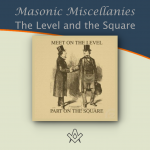 Masonic Miscellanies - The Level and the Square (A Poem) The Level and the Square (A Poem) - "We meet upon the Level, and we part upon the Square – |
 Masonic Miscellanies - The Mystic Tie What is the 'Mystic Tie'? Clue: it's not an item of neckwear! |
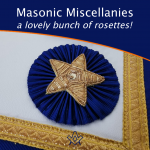 Masonic Miscellanies - A lovely bunch of rosettes! Where did the origin of the use of rosettes on Masonic aprons come from ? |
 Masonic Miscellanies - The Lodge of Sorrow The Lodge of Sorrow - Extracted General Ahiman Rezon, by Daniel Sickles, [1868] |
 Masonic Miscellanies - Memento Mori Memento Mori - a Masonic reminder to make your mark on the world |
 Masonic Miscellanies - A closer look at the Level and the Plumb-rule A closer look at the Level and the Plumb-rule |
 Masonic Miscellanies - The Symbolism of the Gloves The Symbolism of the Gloves and why Freemasons wear white gloves |
 Masonic Miscellanies - Will the real James Anderson please stand up? Will the real James Anderson please stand up? |
 Masonic Miscellanies - The Legend of the Third Degree The most important and significant of the legendary symbols of Freemasonry is, undoubtedly, that which relates to the fate of Hiram Abif. |
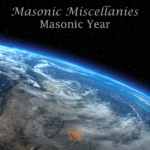 Masonic Miscellanies - Masonic Calendar Why do Freemasons use different 'years' to our regular calendar? |
 Masonic Miscellanies - What is a 'Lewis'? The English word 'Lewis' is a term belonging to operative Masonry, and signifies an iron cramp, which is inserted in a cavity prepared for the purpose in a large stone. |
 Masonic Miscellanies - From J.S.M. Ward Ever wondered why masons had to be 'free' or why we have a Tyler? |
masonic knowledge
to be a better citizen of the world
share the square with two brothers

click image to open email app on mobile device


